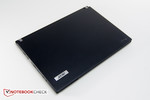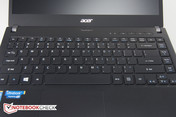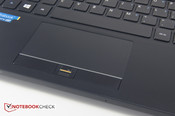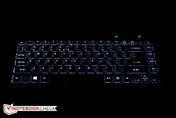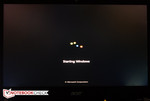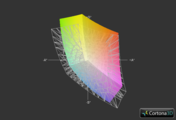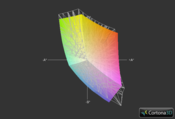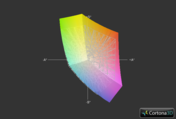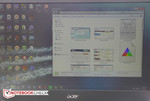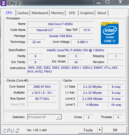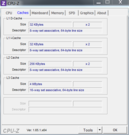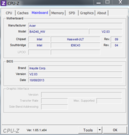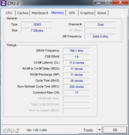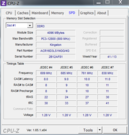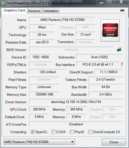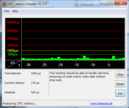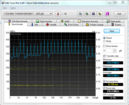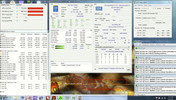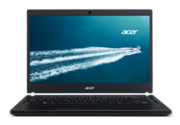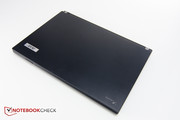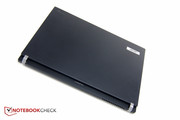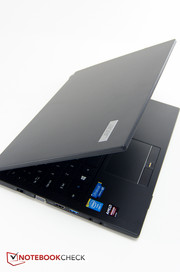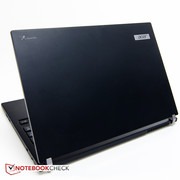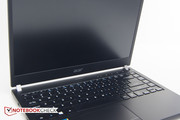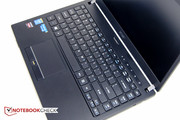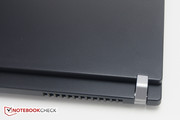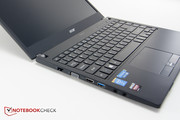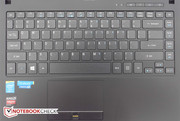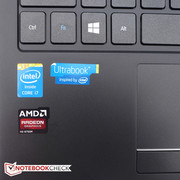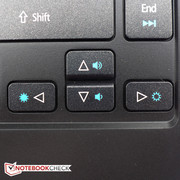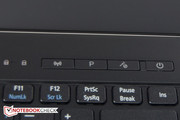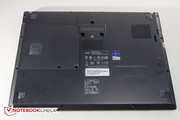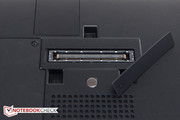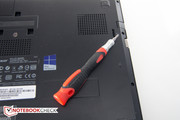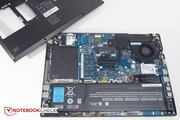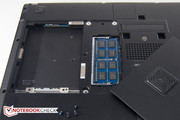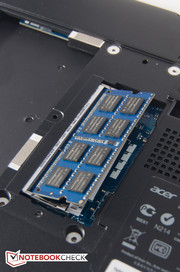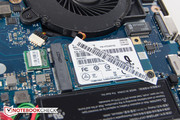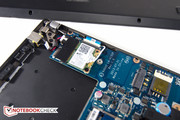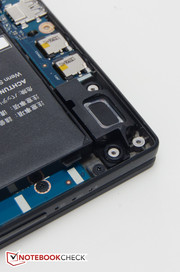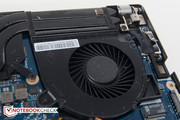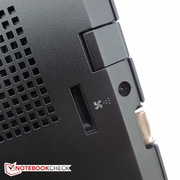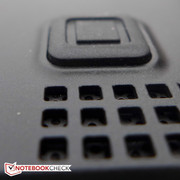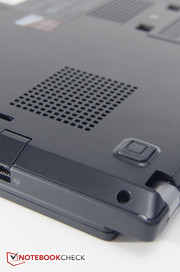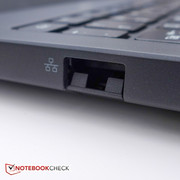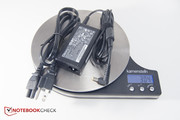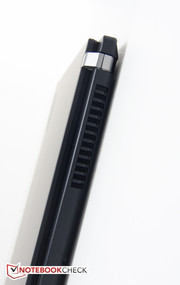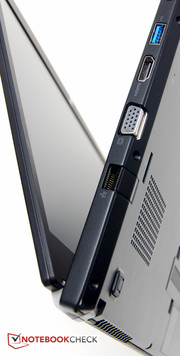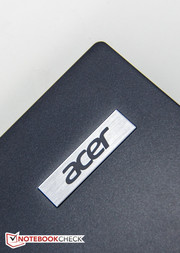Review Acer TravelMate P645-MG-9419 Ultrabook
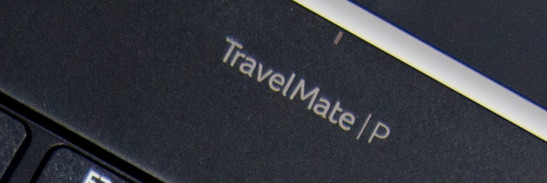
In the fall of 2013, Acer refreshed its business-oriented TravelMate-line with new models and announced the P6 Ultrabook. The newest member of the company's higher-end Travelmate P6-series (there are also series B, P2, P4, and X notebooks) comes with a 4th generation Intel ULV Haswell processor, a large SSD, docking station support, and a business-tailored array of security features. At last count, Acer's website offers 15 models within the P6 series, ranging from a 13.3-inch model with an i3 processor to a 15.6-inch version with a quad-core i7 CPU. There are three versions of the Ultrabook with i5 or i7 processors, 4-8 GB of RAM, and either a 120 or 256 GB SSD. The lowest version with i5-4200U, 4 GB of RAM, 120 GB SSD, integrated GPU, and 1366 x 768 pixel resolution screen has an MSRP of $950.
The average consumer is probably not too familiar with the TravelMate offerings, as the Aspire Ultrabook S3 and the ultra-slim Aspire S7 tend to garner most of the spotlight. The specs of the new Ultrabook should make it a compelling choice for the non-business user as well: in addition to the Haswell i7-4500U. 8 GB of RAM, and the generous 256 GB SSD, the model also sports a dedicated Radeon HD 8750M. Alas - a touch screen is not an option, which might be a turnoff for some prospective buyers, considering that more or less all new notebooks ship with Windows 8. Although the TravelMate does come with the aforementioned OS, our review model arrived downgraded to Windows 7, which is still the number one choice for businesses anyways and the better choice since this Ultrabook is not touch-enabled.
Considering the hardware, the current street price of $1250 also seems quite fair, given that a Lenovo ThinkPad T440s Ultrabook with 256 GB SSD and 8 GB of RAM is closer to $1600 - and that's without a dedicated graphics card. Same is true for the Dell E7440 Ultrabook, which also doesn't come with a dedicated GPU and costs north of $1800 with a Full-HD touchscreen and 4th-generation i5 CPU. From a price/performance standpoint, the Acer definitely has a leg up on the competition. But how does the lesser-known business machine fare compared to the well-known brands?
Case
As a business laptop, the P645 has a no-frills black-on-black design, although there's some glittery specs added to the paint to provide some relief from the monolithic appearance. Readers who are familiar with one of the previous-generation models like the 14-inch TravelMate P643-V-6424, might do a double-take here, as that model relied mostly on aluminum for its construction and didn't have painted surfaces.
Gone are the aluminum deck and display lid: for the new model, Acer uses a magnesium-aluminum alloy cage with a carbon fiber shell. The base unit of the P645-MG-9419 is supremely rigid and doesn't flex at all. The keyboard deck does have some give, however, and the display lid flexes very easily, which leads to color changes and ripples on the screen. Since this is not a touchscreen we don't really have a problem with the less-than-stellar stability here. The new surfaces are also much less prone to show fingerprints, which is certainly a relief.
The Ultrabook measures a scant 327.7 x 236.2 x 20.3 mm, which is about 10 mm less wide than the Dell Latitude 14 and more in line with 13.3-inch notebooks. A quick check reveals that the bezel to the left and right of the screen is indeed exceptionally thin at only about 8 mm. The weight of 1570 grams is comparable to the ThinkPad T440S; the Latitude E7440 is a tad heavier at 1630 grams. Overall, the notebook is easy to handle and fits into most carrying bags with ease.
Connectivity
The port selection is commendable, as there are 3 USB 3.0 ports, full-sized analog (VGA) and digital (HDMI) video-outs, a Ethernet port, as well as separate headphone and microphone jacks. The RJ-45 connector uses the frequently seen drop-down design - in this case, the flap is spring loaded, so it doesn't stay open when not in use and the chance of it getting snagged are minimized.
Unfortunately, Acer still hasn't improved the location of the ports, which is quite disappointing: the two USB ports on the right are in front of the keyboard and close together, which means that a larger device can potentially block the other port. The HDMI port on the left is also in front of the middle line - we would've liked it placed towards the rear so the fairly thick cable stays out of the way when an external monitor is connected.
Communication
Cable-bound access is provided by Intel's I218-M Gigabit network module, while wireless is handled by the Intel Wireless-N 7260 network card. The 2x2 802.11a/b/g/n PCIe Half Mini Card supports both the 2.4 GHz and the 5 GHz band at a maximum theoretical throughput speed of 300 Mbps and Bluetooth 4.0 as well. Acer uses antennas in the top of the display (SignalUp-technology) to improve reception quality and reception is strong with no signal drops. Cellular-based technologies like UMTS are not offered.
Security
As a business notebook, the TravelMate supports Intel vPro, TPM 1.2, face recognition, and comes with a fingerprint reader located between the mouse buttons. Acer ProShield allows the user to secure the Ultrabook from unwanted access from BIOS level on up to application level.
Accessories
The shipping box only contains the laptop, the 65-watt power adapter, and various pamphlets. An interesting optional accessory is the Acer ProDock, which sells online for about $120 and offers a plethora of additional interfaces (VGA, DisplayPort, DVI-D, HDMI, RJ-45, a headphones/speaker jack, microphone-in, line-in, and four additional USB 3.0 ports).
Warranty
Acer supplies the TP645 with a 24-month limited parts & labor, mail- or carry-in warranty against defects with one year of International Traveler's Warranty. Additional warranties are also available, although Acer's website doesn't offer a lot of information here.
Input Devices
Keyboard
The Ultrabook is equipped with a chiclet-style keyboard. The keys measure just short of 15 x 15 mm and are spaced about 3 mm apart. The layout is pretty standard, but as with the TravelMate P643-V-6424, the function-keys and the arrow keys are smaller, although still easy to hit without any errors. Unfortunately, the typing experience is not entirely satisfying: the keys are completely flat and lack tactile feedback, and key travel is restricted to about 1 mm. While we didn't have any problems typing quickly, we do prefer the keyboards found on ThinkPads or Latitudes. While a backlight is available, there is only one setting - on or off. We found the brightness level to be too much for dimly-lit environments and especially at night.
Touchpad
The Synaptics touchpad is adequately sized at 98 x 54 mm and recessed slightly. The surface is slightly rough to the touch and we generally had no issues controlling the cursor, although some multi-touch gestures lagged at times. Acer still uses a standard touchpad design with dedicated buttons, which offer a good travel range and are not as noisy as some other implementations we've seen. The fingerprint reader sits between the buttons but normally doesn't get in the way.
Display
The 14-inch panel is supplied by AUO113D (type B140HAN01.1) and supports Full-HD resolution at 1920 x 1080 pixels. The ThinkPad T440s has 1600 x 900 pixels; the Latitude is offered with either 1366 x 768 pixels or two different Full-HD resolutions both touch and non-touch. Since the P645 does not come with a touchscreen, the panel lacks the glossy properties usually associated with this display type. The good news is that reflections are simply not an issue. Text is also very sharp and even very small fonts are easy to read.
We recorded a maximum brightness of 260 nits across nine quadrants, which falls short of the Full-HD panel of the E7440 by 40 nits, but is brighter than the panel of the T440s by the same margin. The brightness distribution is OK at 83 %, but we noticed an issue with light bleeding, as especially the right bottom corner exhibits backlight spill. Of course this is only noticeable when viewing dark backgrounds. The brightness remains the same even when the Ultrabook is running on battery, which improves outdoor performance.
| |||||||||||||||||||||||||
Brightness Distribution: 83 %
Center on Battery: 276.6 cd/m²
Contrast: 508:1 (Black: 0.544 cd/m²)
ΔE ColorChecker Calman: 5.82 | ∀{0.5-29.43 Ø4.78}
ΔE Greyscale Calman: 7.37 | ∀{0.09-98 Ø5}
58.29% AdobeRGB 1998 (Argyll 1.6.3 3D)
63.2% AdobeRGB 1998 (Argyll 3D)
85.5% sRGB (Argyll 3D)
63.8% Display P3 (Argyll 3D)
Gamma: 2.7
CCT: 5944 K
The black value of 0.54 nits and the corresponding contrast ratio of 508:1 are good for a non-glare display panel. Aside from the issue with the backlight spill, blacks are rendered sufficiently dark and the occasional movie is going to be a decent enough experience. The matte Full-HD panel of the E7740 has a superior contrast ratio of around 870:1; the display of the T440s tops out at a pretty medicre 240:1.
The professional color spaces sRGB and AdobeRGB are covered to almost 80 and 58 %, respectively. The previous-generation TravelMate P643-V-6424 with its budget TN display covered less than 60 % of sRGB, which is similar to the number we recorded for the T440s.
As shipped, ColorChecker showed an average color deltaE-deviation of 5.82. A calibration effort with the X-Rite i1 Pro 2 spectrophotometer didn't change the result much, as the average deviation only dropped to 4.9. The colors are actually balanced fairly well and we don't find the heavy emphasis of blue tones typical for LED displays. Calibration does improve both the gamma value and color temperature, which are now closer to their ideals at 2.38 and 6102 (ideal: 2.2 and 6500K). Color accuracy increases at higher saturation levels with only teal surpassing a DeltaE of 5 at 100 %. The grayscale deviation (DeltaE 7.37) is a bit more pronounced and improves only slightly to 6.49 after calibration. While the panel won't suffice for professional demanding the highest color accuracy, both business and home users should be pleased with the overall quality.
Thanks to the decent brightness, which also remains the same when away from an outlet, the non-glare display is very usable outside in all but the most extreme conditions. Direct sunlight is of course best avoided, but we had no problems viewing the screen content while sitting in the shade or on overcast days.
Performance
At the time of writing, Acer offers the Ultrabook with either a Haswell i5-4200U, i5-4300U, or i7-4500U ULV dual-core processors. Our review model is equipped with the latter CPU, 8 GB PC3-12800 DDR3 SDRAM, dedicated Radeon HD 8750M, and a 256 GB SSD. 4 GB of RAM are soldered onto the motherboard, while the additional slot contains another 4 GB module. The least expensive version with the i5-4200U ships with 4 GB of RAM instead. This model also only has 120 GB SSD, a display with HD+ resolution (1366 x 768 pixels), and, just like the model with the i5-4300U, does not contain a dedicated graphics card.
Processor
The 4th generation ULV i7-4500U CPU has a clock speed of 1.8 GHz and a TDP (thermal design power) of only 15 watts. The base clock speed can be increased to a maximum of 3.0 GHz for a single core via Turbo Boost (2.7 GHz for both cores).
The processor did well in our synthetic benchmark tests and scored 2.81 points running the Cinebench R11.5 Multi 64Bit test. The touch-equipped ThinkPad S440 with the same processor scored an almost identical 2.74 points (-2.5 %). The Latitude E7440 with the i5-4200U trails by -12 % (2.47 points). The performance of the new CPU is quite comparable to the Ivy Bridge Intel Core i5-3210M in both the single and multi-core tests, even though that CPU features a much higher base speed of 2.5 GHz and a Turbo Boost maximum of 3.1 and 2.9 GHz for a single core / for both cores. The big story here is the power consumption, as the i5 CPU is not a ULV model and consumes 35 watts to reach this performance level. The previous-generation 2.0 GHz Intel Core i7-3537U (TDP 17 watts - used in the high-end Samsung Series 7 Ultra Touch) also offers comparable performance and finished the Cinebench R11.5 single-core test with 1.28 points compared to 1.27 points for our review model.
System Performance
The system performance is, thanks to the fast SSD and dual-channel RAM, very snappy as the the PCMark 7 score of 4985 points also shows. The ThinkPad S440 with the same CPU and a Radeon HD 8670M offers nearly the same performance (4883 points). The T440S with the i5-4200U processor ships with a standard hard drive and scores 2287 points, which is a performance reduction of more than 50 %.
The system boots in less than 20 seconds, which is impressive for Windows 7, and programs open without any major delays.
We did notice a reduction in performance while the Ultrabook was running on battery: depending on the benchmark, we recorded a drop of roughly 5 tp 15 percent.
| PCMark Vantage Result | 14426 points | |
| PCMark 7 Score | 4985 points | |
Help | ||
Mass storage
The 256 GB Toshiba THNSNS256GMCP mSATA flash drive Acer uses for this Ultrabook contributes hugely to the very good PCMark 7 and PCMark Vantage scores. HDTune attests the drive an average transfer rate of just above 300 MB/s, which is quite decent, although not nearly as fast as the Samsung SSD 840 installed in the ThinkPad S440 Touch, which managed 435 MB/s. CrystalDiskMark reports very high read and write rates of 465 and 421 MB/s, respectively, although the all-important 4K performance of 18 and 40 MB/s for reads and writes pales in comparison to the S440's 31 and 66 MB/s, The average user won't be able to detect any noticeable performance differences between SSDs during daily use, although the gap to a regular platter-based hard drive is very obvious. We should point out here that the T645 Ultrabook appears to have room for a 7 mm 2.5-inch drive, but Acer doesn't provide the interface connector.
GPU Performance
The Acer TP645 Ultrabook utilizes two graphics cards. The HD 4400 integrated into the i7-4500U is used for task requiring low performance like browsing or word processing, but when 3D power is required, the switchable graphics activates the dedicated middle-class Radeon HD 8750M instead. The DirectX 11.1-capable GPU is based on the 28nm GCN architecture, features a clock speed of 670 up to 870 MHz, comes with 384 shader cores, and addresses 2 GB of dedicated RAM. The 3DMark 11 score of almost 1800 points is neck-on-neck with Nvida's GT 730M Lenovo uses for the T440p.
The performance difference between the HD 8750M and Intel HD 4400 graphics cards is quite noticeable: with the former active, the Ultrabook completed the Unigine Benchmark test at 21.2 fps; with the latter, the frame rate dropped to 13.4 fps - a reduction of about 37 %.
| 3DMark 05 Standard | 17472 points | |
| 3DMark 06 Standard Score | 8878 points | |
| 3DMark Vantage P Result | 6491 points | |
| 3DMark 11 Performance | 1793 points | |
| 3DMark Ice Storm Standard Score | 39579 points | |
| 3DMark Cloud Gate Standard Score | 5592 points | |
| 3DMark Fire Strike Score | 1166 points | |
Help | ||
Gaming Performance
Although this is a business Ultrabook, the TP645 can handle the occasional gaming sessions quite well. Many games run without issues as long as the setting are kept on low to medium quality. BioShock Infinite, for example, will run without any stutters at 1366 x 768 pixels (HD+) and the settings on medium (37 fps) or high (31 fps). Full-HD resolution with ultra-high quality is out of the question, however, as the frame rate drops to an unplayable 11 fps.
Games like Fifa 14 are of course playable with the integrated graphics as well: during our test, the HD 4400 managed framerates of 42 fps even with Full-HD resolution and the settings turned up to ultra-high. The dedicated GPU was able to maintain 78 fps using the same settings. Although the the target audience might not care too much about gaming performance, the Ultrabook acts much more like a multimedia notebook in this regard and clearly outperforms its competitors with integrated graphics only.
| low | med. | high | ultra | |
|---|---|---|---|---|
| Anno 2070 (2011) | 109.8 | 48.1 | 29.7 | 14.4 |
| BioShock Infinite (2013) | 59.7 | 36.8 | 31 | 11.2 |
| Fifa 14 (2013) | 253.6 | 146.5 | 122.5 | 78.3 |
Emissions
System Noise
At idle, the system remains more or less inaudible at below 29 dB. Under load, the noise increases as expected to between 34 and 38 dB depending on the task. During peak load scenarios, the Ultrabook topped out at 44 dB. Rivals like the Lenovo ThinkPad T440s Ultrabook or the Dell E7440 Ultrabook are not quite as noisy at 40 dB and 35 dB, respectively, although it's important to keep in mind that neither system is equipped with a dedicated graphics card.
Although 44 dB is still acceptable, the behavior of the fan might be more of an issue: during our stress test, the system fan switched between the highest and the next lowest setting every few seconds, which can get quite annoying after a while. Fortunately, this is not going to occur during normal usage scenarios.
Noise level
| Idle |
| 28.7 / 28.8 / 28.9 dB(A) |
| Load |
| 30.8 / 44.1 dB(A) |
 | ||
30 dB silent 40 dB(A) audible 50 dB(A) loud |
||
min: | ||
Temperature
During idle, the Ultrabook remains quite cool and barely reaches 30 degrees C in some areas. The palm rests are remarkably cool at less than 5 degrees C above ambient. The picture changes quickly when the system is under load: although the palm rests still remain perfectly cool to the touch at around 27 degrees C, the underside of the notebook in the middle towards the back now heats up to 51 degrees C. We would have expected a hotspot on the rear left, since this is where the fan exhaust resides.
Since both the left and the right bottom areas remain much cooler than the middle section, we were still able to place the Ultrabook on the lap without experiencing any discomfort even during our maximum-load scenario. Since the left leg is blocking the fan intake, however, we would not recommend doing so for extended periods of time.
(-) The maximum temperature on the upper side is 47.6 °C / 118 F, compared to the average of 34.3 °C / 94 F, ranging from 21.2 to 62.5 °C for the class Office.
(-) The bottom heats up to a maximum of 51.2 °C / 124 F, compared to the average of 36.8 °C / 98 F
(+) In idle usage, the average temperature for the upper side is 25.8 °C / 78 F, compared to the device average of 29.5 °C / 85 F.
(+) The palmrests and touchpad are cooler than skin temperature with a maximum of 27.6 °C / 81.7 F and are therefore cool to the touch.
(±) The average temperature of the palmrest area of similar devices was 27.6 °C / 81.7 F (0 °C / 0 F).
Stress Test
To check for heat-related performance drops and throttling, we use Prime95 and FurMark while running various monitoring tools. During idle, the CPU cores maintained their Turbo Boost maximum of 2.7 GHz with one or the other core jumping up to 3.0 GHz. A few minutes after starting up Prime95 on its own, both cores settled at 2.4 GHz with occasional dips to 2.3 GHz and temperatures between 67 to 70 degrees C. A check after an additional 15 minutes revealed CPU temps of about 68 degrees with speeds between 2.4 and 2.5 GHz. From here on out we didn't observe any changes.
With no load present, the Radeon GPU idled at 300 MHz and 36 degrees C. With FurMark active, the GPU immediately jumped from its idle speed to 825 MHz with dips down to 775 MHz. The temperature of the GPU climbed to about 67 degrees C within the first 30 seconds. The system stabilized eventually with the GPU maintaining 775 MHz with occasional drops to 650 MHz at a temperature of 75 degrees C . During graphic-intensive loads, the CPU cores maintained their maximum of 2.7 GHz with a temperature of less than 40 degrees C.
For the full stress test, we run both Prime95 and FurMark in parallel. The CPU dropped to around 2.3 GHz shortly after the start, while the GPU maintained its maximum of 825 MHz. At the 10 minute mark, the CPU had dropped to its nominal frequency of 1.8 GHz with CPU temperatures of around 75 degrees C. The GPU frequency had dropped slightly to 775 MHz with dips to 650 MHz at a temperature of about 71 degrees C. When we placed the Ultrabook on the lap and partially blocked the cooling intake in the process, the CPU reached its maximum recorded temperature of 86 degrees C, but still maintained 1.8 GHz (no throttling). The GPU remained at around 775 MHz, although the temperature had increased to a peak of 77 degrees C.
When we placed the laptop on our glass table with the fan intake hanging over the edge, the GPU and CPU temperatures dropped to 63 and 70 degrees C, respectively. While we didn't observe any changes on the GPU side aside from the temperature drop, the processor frequency did jump to 2.4 GHz. When we put the Ultrabook back on the table, the temperatures increased to their previous levels and the CPU speed dropped back down to 1.8 GHz. This clearly is a system which would benefit from better cooling air flow. The rubber feet on the bottom of the notebook don't seem to be sized properly and the system is thus starving for air when both the GPU and the CPU are at their limits. The attached screenshot labeled "Stress Test: Prime95 + Furmark" clearly shows this behavior (see the GPU temperature graph marked in red).
Benchmark test immediately after the stress test showed no relevant drop in performance.
Speakers
The two stereo speakers sit on the front edge and fire towards the surface the Ultabook is sitting on. The sound quality is OK, but not great, which is not entirely unexpected for this class of notebook. The sound volume is adequate, but mids can be muddled at times. While sufficient for presentations, we would still recommend headphones - especially when listening to music.
Battery Life
To simulate the battery life, we perform several tests with all screen and other timeouts disabled. For the maximum run time, we use the tool Battery Eater and run the Reader's test. The Power Saver profile is active, we disable all wireless radios and turn the display brightness all the way down. The TP645 Ultrabook lasted for about after 13 hours and 15 minutes, which beats both the ThinkPad T440s and the Latitude E7440 by about two hours.
To determine the minimum battery life, we enable the High Performance profile, enable all wireless radios, maximize the screen brightness, and run the Battery Eaters Classic Test. The TP645 lasted for just under 2 hours before we had to plug it back in.
To simulate a more relevant usage scenario, we run the WLAN test. Here, we use the Balanced profile, set the brightness to 150 nits, and run a script which visits different types of websites in 40 second intervals. The Ultrabook lasted for 8 hours and 40 minutes, which is an excellent result. The ThinkPad T440s lasted just shy of 6 hours; the Latitude E7440 shut down after 5 hours and 17 minutes.
The TP645 will easily last the average workday, provided that the loads are fairly light and don't make use of the dedicated GPU.
Verdict
Acer's TravelMate P645-MG-9419 Ultrabook is a very functional, portable, and well-build business notebook. The up-to-date Haswell hardware offers good performance, the battery lasts through an entire workday, and the price seems quite reasonable. The Full-HD display panel is bright, colors look good, and text is easy to read. The dedicated Radeon GPU improves 3D performance and should make those who are inclined to play games once in a while quite happy.
The TP645 does run fairly hot when under heavy load though, so a laptop cooling pad might not be a bad idea for CPU- and GPU-intensive tasks.
Our one major issue with the TP645 concerns its keyboard. While it is certainly up to consumer Ultrabook standards, it is not nearly as refined as the high-quality keyboards offered on many ThinkPads, Latitudes, or EliteBooks. Low price notwithstanding, demanding business customers are going to have a hard time with this obvious shortcoming.
Acer does many things right with the P645. If the keyboard could be improved, the Ultrabook could be a very viable alternative to the the business offerings from the stalwarts Dell, Lenovo, and HP, while costing hundreds of Dollars less.




